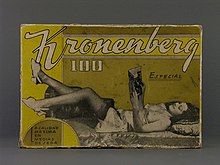Historically, even though the word sock is at least as ancient in origin, what men normally wore were often referred to as stockings, probably especially when referring to longer hose.[1][2][verification needed] The word stock used to refer to the bottom "stump" part of the body, and by analogy the word was used to refer to the one-piece covering of the lower trunk and limbs of the 15th century—essentially tights consisting of the upper-stocks (later to be worn separately as knee breeches) and nether-stocks (later to be worn separately as stockings). (See Hose.)
Before the 1590s, stockings were made of woven cloth. The first knitting machines were for making stockings.[3] The stockings themselves were made of cotton, linen, wool or silk. A polished cotton called lisle was common, as were those made in the town of Balbriggan.
Before the 1920s, stockings, if worn, were worn for warmth. In the 1920s, as hemlines of dresses rose and central heating was not widespread, women began to wear flesh-colored stockings to cover their exposed legs. Those stockings were sheer, first made of silk or rayon (then known as "artificial silk") and after 1940 of nylon.
The introduction of nylon in 1939 by chemical company DuPont began a high demand for stockings in the United States with up to 4 million pairs being purchased in one day. Nylon stockings were cheap, durable, and sheer compared to their cotton and silk counterparts. When America entered World War II, DuPont ceased production of nylon stockings and retooled their factories to produce parachutes, airplane cords, and rope. This led to a shortage and the creation of a black market for stockings. At the end of the war DuPont announced that the company would return to producing stockings, but could not meet demand. This led to a series of disturbances in American stores known as the nylon riots until DuPont was able to increase production.[4]
A precursor of pantyhose made an appearance in the 1940s and 1950s, when film and theater productions had stockings sewn to the briefs of actresses and dancers, according to actress-singer-dancer Ann Miller[5] and seen in popular films such as Daddy Long Legs. Today, stockings are commonly made using knitted wool, silk, cotton or nylon (see hosiery). The introduction of commercial pantyhose in 1959 gave an alternative to stockings, and the use of stockings declined dramatically. A main reason for this was the trend towards higher hemlines on dresses (see minidress). In 1970, U.S. sales of pantyhose exceeded stockings for the first time, and has remained this way ever since.[6] Beginning in 1987, sales of pantyhose started a slight decline due to the newly invented hold-ups, but still remain the most sold kind of hosiery.
Stockings are still sometimes preferred to pantyhose in North American English, for a number of reasons. These may include the perception that stockings, and the associated use of garters, lace, high fashion, appliqué and the exposure of the thigh, are more aesthetically pleasing, or sexually attractive and alluring than pantyhose.
Both nylon stockings and pantyhose in being sheer share the advantage of being quick-drying compared to pants. Spare pairs are also easy to carry if they are ruined. If laddered they can be replaced 'one at a time' which provides a cost advantage over tights.
However, stockings have a drawback in colder weather, because more skin is exposed to the cold compared to pantyhose. Also, pantyhose do not require garters or garter belts, and do not need to be adjusted as much, whilst also leaving a smoother line under form-fitting clothing.
The following comes from Smithsonian Magazine: https://www.smithsonianmag.com/smithsonian-institution/how-nylon-stockings-changed-world-180955219/#:~:text=Nylon%20stockings%20made%20their%20grand,sold%20out%20in%20four%20days.
Nylon stockings made their grand debut in a splashy display at the 1939 World’s Fair in New York. By the time the stockings were released for sale to the public on May 15, 1940 demand was so high that women flocked to stores by the thousands. Four million pairs sold out in four days.
In her book Nylon; The Story of a Fashion Revolution, Susannah Handley writes: “Nylon became a household word in less than a year and in all the history of textiles, no other product has enjoyed the immediate, overwhelming public acceptance of DuPont nylon.”
The name may have become synonymous with stockings, but hosiery was merely the market of choice for nylon’s introduction. According the American Chemical Society it was a well calculated decision. They state on their web site:
The decision to focus on hosiery was crucial. It was a limited, premium market. "When you want to develop a new fiber for fabrics you need thousands of pounds," said Crawford Greenewalt, a research supervisor during nylon development who later became company president and CEO. "All we needed to make was a few grams at a time, enough to knit one stocking."
https://youtu.be/1yQCqBaHC6Y
The experimental stockings were manufactured by Union Hosiery Company for Dupont with a cotton seam and a silk welt and toe. They were black because scientists hadn’t yet figured out how to get the material to take flesh-colored dye. One of the other hurdles to be overcome was the fact that nylon distorted when exposed to heat. Developers eventually learned to use that property to their advantage by stretching newly sewn stockings over leg-shaped forms and steaming them. The result was silky smooth, form-fitting hosiery that never needed ironing.
Nylon’s impact on fashion was immediate, but the revolution sparked by the invention of what was originally called fiber-66 rapidly extended its tendrils down through every facet of society. It has given rise to a world of plastics that renders our lives nearly unrecognizable from civilizations of a century ago.


No comments:
Post a Comment